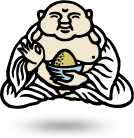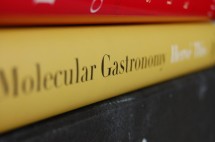Translate This: Hervé This
Posted by Pailin Chongchitnant on Tuesday, June 14th, 2011Tags for this Article: Crème Anglaise, Hervé This, molecular-gastronomy, poached pear, recipe
Mark Busse told me on our first meeting that through a chain of events, he ended up with a whole bunch of original recipes directly given to him by Hervé This, the grandfather of molecular gastronomy. I was sufficiently ecstatic by this point of the story, but when he proceeded to tell me that he was frustrated by the fact he can’t post it on Foodists because it’s all in French…I was certain it was just meant to be. I mean, I know French, I am a Foodist…so the logic would follow that I should translate it and post it on Foodists. So here it is.
Now, a little prelude. When I first got the document, I was a little perplexed as they didn’t look anything like recipes to me. The document seems like it’s not yet a final draft, so it’s a little confusing to read through at first, and the recipes are more like…guidelines–no exact measurements, and it’s written as though someone is verbally explaining to you how to make something. It’s rather endearing actually. The document is divided in two columns called “The Principle of the Dish” and “In Practice.” I don’t know the background of this document at all, perhaps it was a rough note for a book? I don’t know. Someone had attempted to translate the first page, as the first page is in English, but that’s all they got through. I perused through the pages and found something substantial I thought would be of interest to fellow Foodists–I decided to translate the scientific analysis of the classic dessert: wine-poached pear with creme anglaise. It was quite an amusing project as you can almost see his personality coming through the way he phrased certain things and the little comments he made along the way.
It’s worth noting here, that I kept it as true to the original as possible to preserve as much of the French character as possible, and I resisted rephrasing things unless it would just be awkward to read. I made a couple of footnotes to clarify some things. This is just the first half of it, it is lengthy and rather intriguing, so I figured it would be exciting to keep everyone in suspense of the sequel. Here goes:
Poached Pear with Crème Anglaise
-The Principle of the Dish-
In the kingdom of desserts, like in savory cuisine, there remain hundreds of mysteries and many innovations are still a possibility. Here, we are most interested in the flavor, the finish1, the coloration of the fruit, the caramelization, and the crème anglaise.
We are basing our experimentation on a classic recipe of wine-poached pear served with a crème anglaise. I believe it’s not necessary to write down the original recipe here—you poach a pear in red wine, serve it on some crème anglaise, and glaze it with caramel sauce.
First order of business—the pear. Auguste Escoffier and the chefs of his time had said that red fruits should never be put in tin-lined copper vessels. However, when I did put raspberries in a tin-lined copper pot…nothing changed in appearance nor taste. So were the chefs of the past mistaken? Let’s be careful and further investigate the problem. If they advised against it, they must have observed some effect that we need to look for.
Let us use our reasoning: they talked about “red fruits,” which could be stawberries, raspberries, red currants…but no effects were visible with these fruits. Let’s reason further: if they specified tin-lined copper, it could be the copper, it could be the tin, or it could be the combination of the two metals. In that case, let’s isolate each metal and put the red fruits together with copper, tin, and then both metals…still, nothing happened. Did they really make a mistake? But let’s trust in them and continue our thinking. These metals often get oxidized, and it’s perhaps the oxide of copper or tin that is intervening here. In three bowls, let’s mash some raspberries, adding to the second bowl some tin salt2, and to the third bowl some copper salt.2 This time, there was a visible effect! The raspberries mixed with the copper salt took on a lovely orangey red tint, while those mixed with tin salt turned an awful shade of violet. Those chefs had really seen something here, but the advice was imprecise: one should in fact say, “never put red fruits in contact with a tin oxide or they will turn blue,” or “never put red fruits in a tin vessel that has not been meticulously cleaned.”
And the pears? The same chefs who described the transformation of red fruits also said that the pear compote turns red when you cook the pears with sugar and a small piece of tin. However, after some trials, I still have never seen a pear turn red from anything other than being poached in red wine. How about you? Don’t hesitate to write me if you’ve seen the reddening of pears in the presence of tin, and please specify the conditions under which this happened: the variety of pear, the ripeness of the pear, the proportion of water to pear to sugar, the type of tin used, the cooking method…
And since I don’t know how to turn pears red using tin, let us examine the red wine method. A number of chefs start by reducing the red wine, and then adding a fresh dose of the same wine back to it before poaching. Why the reduction? After having done research (I prefer to spare you the details of the research and just give you the results), the reduction of wine results in a caramelization of glucose in the wine. In other words, we reduce the wine in order to turn glucose into caramel. It is interesting to note that table sugar, sucrose, is made up of half glucose and half fructose. If you cook table sugar in acid, the two halves will split, allowing you to make a fructose caramel plus a glucose caramel rather than only a sucrose caramel. The other conclusion we can make is that when you reduce the wine, it is possible to promote caramelization by adding sugar to the wine (and a drop of lemon juice to help acidify the wine, which will then promote the dissociation of glucose and fructose.)
When you are poaching, there’s not much to point out other than the fact that you could add half a sheet of gelatin or a little bit of flour to the poaching liquid. Why ? Because gelatin, like flour, contains molecules shaped in long strings which would wrap themselves around aromatic molecules and prevent them from evaporating. So in the wine you’re using to poach the pear, add cinnamon sticks, flour, and gelatin to prevent your dessert from losing its aroma. Cover the pot and let the pear sit in its poaching liquid until cool.
To be continued…
-Pailin’s Notes:
1The term used here was “longueur en bouche” which is literally translated to length in the mouth. A term normally used in wine tasting, it refers to the aromas and flavors that remain in the mouth after swallowing. The term “aftertaste” is not used as it has a negative connotation.
2Tin salt, copper salt or any other metal salts (having to dig up my chemistry knowledge here) refers to a compound made of positively charged metal ions and negatively charged non-metal ions, i.e. oxygen ions.



Posted on June 20th, 2011
degan says:
Pailin this is great! I’ve been working on it too but it always seems to get set aside. YAY.
Posted on June 20th, 2011
Brenda says:
This is fascinating, I’m looking forward to Part 2!